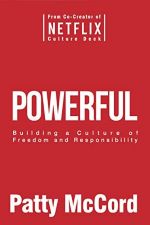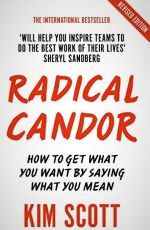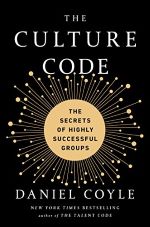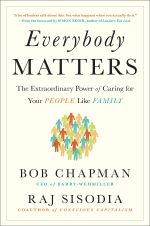What, exactly, is workplace culture? Is it something we create from the top down or something that evolves from the bottom up? Can culture even be “created”? Perhaps it is a co-creation of a company’s leadership and the employees whose personalities and attitudes power it.
Whether you work at a super-flexible, anything-goes startup or a century-old button-down corporation, workplace culture can make or break not only how fulfilling people’s jobs are, but how productive, innovative and adaptive they are — which determines a company’s ultimate success.
Here we’ve gathered several approaches to identifying, understanding and shaping workplace culture. As you will see as you browse these selections, no two company cultures are the same, nor should they be. The key is to find what works for your organization’s needs.

Powerful: Building a Culture of Freedom and Responsibility by Patty McCord
Powerful: Building a Culture of Freedom and Responsibility by Patty McCord

Radical Candor: Fully Revised and Updated Edition: How to Get What You Want by Saying What You Mean by Kim Scott
McCord shares what she learned as chief talent officer for Netflix: that most companies have it all wrong when it comes to recruiting, creating and motivating teams. Workplace perks, annual performance reviews and employee engagement programs often end up being a colossal waste of time and resources, she argues. Instead, McCord advocates practicing “radical honesty” in the workplace, embracing turnover to adapt to emerging needs and motivating people with work that challenges them. Mutual respect, empathy and creativity are more important to team culture than “pajama Mondays.” Discussing the big picture, debating the particulars and keeping focused on the future is the path to keep teams engaged. Along the way, Scott demonstrates how to implement cultural changes to bring out the best in everyone ― including yourself.

The Culture Book, Volume I: When Culture Clicks by Weeva & Culturati
Radical Candor: Fully Revised and Updated Edition: How to Get What You Want by Saying What You Mean by Kim Scott

The Fear-Free Organization: Vital Insights from Neuroscience to Transform Your Business Culture by Paul Brown, Joan Kingsley and Sue Paterson
This is a book with a much-needed message for leaders looking to build and inspire teams. We’re highlighting the revised and updated edition, as it contains some excellent bonus features that increase its usefulness. So many managers spend time and energy to be liked by their charges; but, as Scott argues, this is setting both you and your team up for failure. It’s okay to be personable, and even essential to have a strong relationship with your reports, but at the end of the day, your job is to make sure the work gets done. Managers can deliver higher levels of success by embracing what Scott calls “fierce conversations.” She has identified three principles for building better relationships with employees: make it personal, get stuff done and understand why it matters. Within these principles lies advice for providing guidance and feedback, encouraging growth and making better decisions — and doing all of it with integrity and humanity.


Everybody Matters: The Extraordinary Power of Caring for Your People Like Family by ob Chapman and Raj Sisodia
If you are looking for a variety of approaches to building a better company culture, look no further than this easy-to-digest compendium. It represents the wisdom of 32 companies that have transformed their workplaces to improve recruitment, retention, performance and profitability. Co-authored by the organizers of the Culturati annual conference, the book curates the insights of a bevy of thought leaders that include the aforementioned McCord and Scott, along with C-suite executives across many organizational roles and industries. Each chapter highlights different aspects of the journey to building strong, resilient and vibrant workplaces. Some are delivered Q&A style, others contain helpful infographics to boil down key concepts. At the heart are topics of much discussion and debate, such as: Who owns company culture? Is culture all about values, or behavior, or something else? What are the elements of exceptional culture? Does culture have an ROI or is it just squishy? Can you copy culture? How do you know what your culture actually is? If you haven’t been able to attend any conferences this year on this topic due to Covid-19, this is the next best thing.
The Fear-Free Organization: Vital Insights from Neuroscience to Transform Your Business Culture by Paul Brown, Joan Kingsley and Sue Paterson
Leadership that makes a difference takes guts and confidence, plus belief in oneself and belief in the key players in the organization. It is built on trust, not fear. Scared people spend a lot more time plotting their survival than working productively, so The Fear-Free Organization has zero-tolerance for bullies, vicious gossip, undermining behaviors, hijacking tactics, political jockeying for position or favoritism. Instead, it works on inspiration. Evidence from neuroscience shows that individuals and organizations are more successful when people are encouraged to take risks, to explore new ideas, and to channel their energies in ways that work for them. The Fear-Free Organization reveals how our new understanding of the neurobiology of the self — how the brain constructs the person — can transform for the better the way our businesses and organizations work. Check out our fascinating interview with book co-author Joan Kingsley here.
In his New York Times bestselling business book, Coyle tackles some very big questions about high-performing teams. Where does great culture come from? How do you build and sustain it in your group, or strengthen a culture that needs fixing? To find out, he studied some of the world’s most successful companies — such as Zappos and IDEO — as well as other types of organizations, including the U.S. Navy’s SEAL Team Six, the San Antonio Spurs, the comedy troupe Upright Citizens Brigade, and even a gang of jewel thieves — all to learn what made them so cohesive and motivated. It turns out, culture is not something you are; it’s something you do. And Coyle found three key skills at the heart of what these organizations do: build safety (connection, belonging, identity), share vulnerability (mutual risk, trust, cooperation), and establish purpose (narratives, goals, values). Along the way, he gives plenty of examples and advice to build these skills among leaders in your organization.
Portfolio
At one time, people mattered. Companies invested in their employees, financially and emotionally. It was important for companies to have “lifers,” people who saw the company as “family,” as a place that nurtured and provided for them. At some point, though, that changed. Management tactics shifted. At one such company, writes author and CEO Bob Chapman, problems were met with “frequent restructurings and layoffs [that] succeeded only in exacerbating its problems, damaging its culture, and destroying morale. “Fear and distrust were rampant,” Chapman writes. “A corrosive ‘us vs. them’ mentality pervaded the company: union vs. nonunion, office vs. shop, management vs. workers.” Instead of growing employees’ skills to adapt to and leverage change, companies scaled up and down, treating employees as the sum of the skills they already possessed, not their capacity for unlimited potential. Chapman and co-author Raj Sisodia, show how any organization can embrace a more human approach, rejecting the consequences of layoffs, dehumanizing corporate rules and hypercompetitive workplace cultures. Read our full review here.




